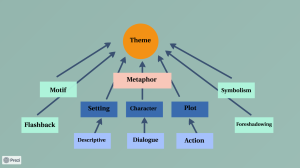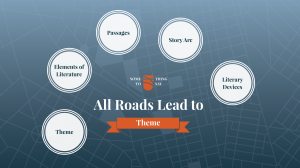7 All Roads Lead to Theme
Learning Objectives
-
Understand the interconnected nature of the elements of literature.
-
Cite specific textual evidence to support inferences and conclusions drawn from the text.
Chapter & Discussion
This chapter includes a presentation that can be navigated in a classroom setting or independently. You can access the presentation via the link below.
Work through the different sections of the chapter and discuss ideas and topics as they arise. If you’re working independently, take notes instead. Notes and active discussion will be helpful in navigating this week’s assignments.
Review: What is Theme?
Theme is the thing the author is trying to say.
This is the message or perspective the author seeks to communicate through this work. Ultimately, all elements of literature help authors say what they are trying to say.
Metaphor is a powerful tool that makes it possible to use the elements of literature, passages, the story arc, and literary devices to communicate themes.
This is the major working principle of literature.

Today, we’ll review all of the vocabulary and literary principles we’ve studied and note how each piece can help an author say what they’re trying to say.
Elements of Literature
These are the major working parts: setting, character, and plot.
Setting
The circumstances (like time and place) that shape the world and influence the characters’ choices.
These circumstances help the author communicate themes and often serve as metaphors for the author’s ideas.
Character
These are the people who experience the story.
They witness the author’s main ideas first-hand.
They might learn a lesson and/or come to understand the author’s perspective.
Plot
What happens. The events of the story are the consequences of characters’ choices.
These events are designed to help an author communicate ideas or share perspectives.
(Or, alternatively, the story someone has to tell is a reflection of their perspectives)

Passages
The actual written paragraphs in the story.
Descriptive
These are expository.
They give background information and help us understand setting and characters.
Setting and characters are big metaphors for the things the author is trying to say.
Action
These passages tell us what happens. They inform the plot.
The plot is a big metaphor the author is using to communicate a theme (or perspective).
Story Arc
The “steps” of a story over time.
Exposition
Background information. World-building.
The world is a metaphor for what the author is trying to say.
The better we understand it, the more we engage with the theme.
Rising Action
This establishes the stakes and raises the tension.
It helps us develop a relationship with the characters and become invested.
If we’re invested, we develop a personal relationship with the author’s message.
Climax
The breaking point. The moment where the outcome is decided.
This happens with a choice.
That choice reflects the theme and allows it to resonate.
Falling Action and Resolution
The world is different now, as a result of these events.
The story’s theme facilitated this change.
These sections help readers make sense of the new world, where the author’s message is now a part of life.

Literary Devices
Literary devices are expressions of an author’s personality in literature. They are the little tricks and fun elements that authors use to make the story (and experience) more interesting.
Because they help the author express their personality, they are also very good at communicating themes (the author’s big ideas- their messages and worldviews that they are trying to share by writing).
Metaphor
A metaphor is a poetic comparison:
usually between very different things
and usually seeing the second thing through the lens of the first
Metaphor is the primary way that people express their personalities. For this reason, it’s a major driving force of how literature works.
All figurative language (and most literary devices) are some kind of metaphor.
Motif
A motif is a feature or phrase that repeats again and again throughout a story.
This can take the form of an image, a setting element, or a line of dialog. When we’re brought to something again and again, we stop and think critically about that element.
A repeated phrase can offer very powerful poetic resonance.
Foreshadowing
Foreshadowing is when the author gives us clues about what might happen in the future. This often happens at the end of a chapter.
It can help us to be more engaged by making us wonder about the big picture and the repercussions of choices down the line.
In the end, everything you read is somehow helping the author communicate themes. We write because we have something to say.
Assigned Reading
Here are this week’s readings. Additionally, please read for your own personal enjoyment for 1/2 hour each day. This will be called your “Reading Zone” reading and it will coincide with many upcoming activities.
What is a Theme? by J T Bushnell (via Oregon State University)
Practice Set: All Roads Lead to Theme
Click here to complete a practice set that explores concepts from the chapter.
Also, here is a cumulative practice set for chapters 1-7.
These practice sets are designed to resemble the types of questions you’ll encounter on the GED RLA test. In this case, I am including a full novel chapter so that the reading can be engaging and so that you can have meaningful practice in the skill of close reading.
All of the practice sets in the Literature Unit will take on this format so that you can engage in enough practice to level up your reading skills while having access to literature that’s worth your time.
Assignment: Literary Vocabulary Review
Attempt to define (or give an example of) each of the literary vocabulary terms below from memory. Then, go back through your notes and this week’s presentation and highlight the ones you got right in green.
-
Theme
-
Setting
-
Character
-
Plot
-
Dialogue
-
Descriptive Passage
-
Exposition
-
Rising Action
-
Climax
-
Metaphor
-
Foreshadowing
-
Motif
Assignment: Reading Zone Response (250 Words)
For Reading Zone, you must find a novel that is interesting to you and enjoyable to read. If you need help finding a Reading Zone book, please ask. Please read your Reading Zone book for a half-hour each day. On class days, there will be time in class dedicated to reading.
Create a response to this week’s reading that addresses the following prompts:
-
In one paragraph, summarize what you’ve read this week
-
In a second paragraph, answer this week’s prompt: What are you connecting the most with in this book? What are some of the author’s ideas that you appreciate? How is this author trying to share those ideas with readers?


